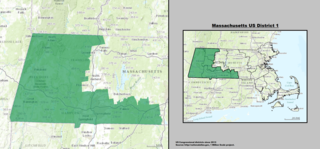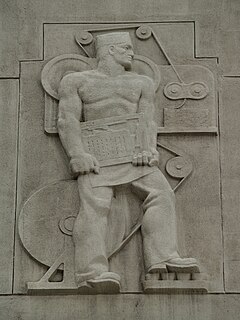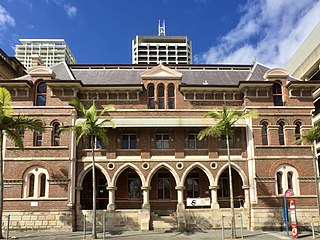
The First Army is the oldest and longest established field army of the United States Army, having seen service in both World War I and World War II, under some of the most famous and distinguished officers of the U.S. Army. It now serves as a mobilization, readiness and training command.
The Public Printer of the United States was the head of the United States Government Publishing Office (GPO). Pursuant to 44 U.S.C. § 301, this officer was nominated by the President of the United States and approved by the United States Senate. In December 2014, Congress passed and President Obama signed into law H.R. 83, which consolidated and continued appropriations for FY 2015. Section 1301 of that act changed the name of the Government Printing Office to the Government Publishing Office and the title of Public Printer to Director. Thus, Davita Vance-Cooks was the last Public Printer of the United States and the first Director of the U.S. Government Publishing Office.

The Federal Depository Library Program (FDLP) is a government program created to make U.S. federal government publications available to the public at no cost. As of March 2018, there are 1,141 depository libraries in the United States and its territories. A "government publication" is defined in the U.S. Code as "informational matter which is published as an individual document at Government expense, or as required by law".

The Comptroller General of the United States is the director of the Government Accountability Office, a legislative branch agency established by Congress in 1921 to ensure the fiscal and managerial accountability of the federal government. The Budget and Accounting Act of 1921 "created an establishment of the Government to be known as the General Accounting Office, which shall be independent of the executive departments and under the control and direction of the Comptroller General of the United States". The act also provided that the "Comptroller General shall investigate, at the seat of government or elsewhere, all matters relating to the receipt, disbursement, and application of public funds, and shall make to the President when requested by him, and to Congress... recommendations looking to greater economy or efficiency in public expenditures."
The Comptroller General is appointed for fifteen years by the President of the United States with the advice and consent of the Senate per 31 U.S.C. § 703. Also per 31 U.S.C. § 703 when the office of Comptroller General is to become vacant the current Comptroller General must appoint an executive or employee of the GAO to serve as the Acting Comptroller General until such time as a new Comptroller General is appointed by the President and confirmed by the Senate.

The United States Statutes at Large, commonly referred to as the Statutes at Large and abbreviated Stat., are an official record of Acts of Congress and concurrent resolutions passed by the United States Congress. Each act and resolution of Congress is originally published as a slip law, which is classified as either public law or private law (Pvt.L.), and designated and numbered accordingly. At the end of a Congressional session, the statutes enacted during that session are compiled into bound books, known as "session law" publications. The session law publication for U.S. Federal statutes is called the United States Statutes at Large. In that publication, the public laws and private laws are numbered and organized in chronological order. U.S. Federal statutes are published in a three-part process, consisting of slip laws, session laws, and codification.

Massachusetts's 1st congressional district is located in western and central Massachusetts. The largest Massachusetts district in area, it covers about one-third of the state and is more rural than the rest. It has the state's highest point, Mount Greylock. The district includes the cities of Springfield, West Springfield, Pittsfield, Holyoke, and Westfield.

Massachusetts's 2nd congressional district is located in central Massachusetts. It contains the cities of Worcester, which is the second-largest city in New England after Boston, and Northampton in the Pioneer Valley. It is represented by Democrat Jim McGovern.

Massachusetts's 3rd congressional district is located in northeastern and central Massachusetts.
The Joint Committee on Printing is a joint committee of the United States Congress devoted to overseeing the functions of the Government Publishing Office and general printing procedures of the federal government of the United States. The authority vested in the Committee is derived from 44 U.S.C. § 101 and the Committee is thereby responsible for ensuring compliance by federal entities to these laws and the Government Printing and Binding Regulations. The current joint committee was created by the Legislative Reorganization Act of 1946 and combined the functions of the United States House Committee on Printing and the United States Senate Committee on Printing

Massachusetts's 8th congressional district is located in eastern Massachusetts, including part of Boston. It is represented by Democrat Stephen Lynch. For one congressional term (1791–1793) it served as the home district of the District of Maine. The district boundaries were significantly changed as of the elections of 2012 due to redistricting after the 2010 census, with the old 8th district largely being shifted to the new 7th district. The new 8th district comprises many of the communities of the old 9th district, as well as some easternmost Norfolk County communities and northernmost Plymouth County communities of the old 10th district.

Massachusetts Congressional District 11 is an obsolete congressional district in eastern Massachusetts. It was eliminated in 1993 after the 1990 U.S. Census. Its last Congressman was Brian Donnelly; its most notable were John Quincy Adams following his term as president, eventual president John F. Kennedy and Speaker of the House Tip O'Neill.

Maryland's 8th congressional district stretches from the northern Washington, D.C. suburbs north towards the Pennsylvania border. The district is currently represented by Democrat Jamie Raskin.

Massachusetts's 10th congressional district is an obsolete district that includes parts of the South Shore of Massachusetts, and all of Cape Cod and the islands. The District has existed since 1795, but was removed for the 113th Congress in 2013 as district lines were redrawn to accommodate the loss of the seat due to reapportionment as a result of the 2010 Census. Effective from the elections of 2012, most of the district falls into the new Massachusetts 9th congressional district, with some northern portions falling in the new 8th district.

Massachusetts's 14th congressional district is an obsolete district which was in eastern Massachusetts and the Maine District. It was eliminated in 1963 after the 1960 U.S. Census. Its last Congressman was Joseph William Martin, Jr., who was redistricted into the tenth district.

Massachusetts's twelfth congressional district is an obsolete district. It was eliminated in 1983 after the 1980 U.S. Census. Its last location was in southeastern Massachusetts and its last Congressman was Gerry Studds, who was redistricted into the tenth district.

Massachusetts's thirteenth congressional district is an obsolete district. It was also for a short time in the early 19th century a Massachusetts District of Maine. It was eliminated in 1963 after the 1960 U.S. Census. Its last location was in eastern Massachusetts. Its last Congressman was James A. Burke, who was redistricted into the eleventh district.

Massachusetts's fifteenth congressional district is an obsolete district. It was also for a short time in the early 19th century a Massachusetts District of Maine. It was eliminated in 1943 after the 1940 Census. Its last location was in eastern Massachusetts at Cape Cod. Its last Congressman was Charles L. Gifford, who was redistricted into the ninth district.

The Congressional Pictorial Directory is a picture directory of leaders and members of the United States Congress and other key officials including the President. It is published at least once every Congressional Term and is in the public domain. It was previously published as the Pocket Congressional Directory.













